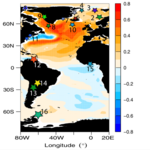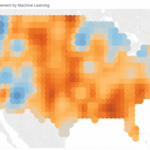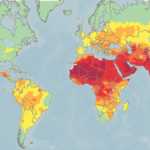Atmospheric

The Little Ice Age, lasting from early 15th to mid-19th centuries, was one of the coldest periods of the past 10,000 years - since the last real Ice Age ended.
Why it happened is one of the persistent questions in historical climatology.
The cold spell set in around 600 years ago and was responsible for crop failures, famines and pandemics throughout Europe, resulting in misery and death. A sudden change from very warm conditions in the late 1300s switched to unprecedented cold conditions only 20 years later.
A new study finds the cooling appears to have been triggered by warming. Using…

There is a saying that goes 'lightning doesn't strike in the same place twice' but it was never wise to bet your life on it. What it means is that getting hit at all is rare, for a human well over a 1 in 1,000,000 chance, but even if only 300 people are hit and under die, it still happens a lot to other things. The Empire State building in New York City gets hit 25 times each year.
A new paper says if lightning is going to strike in the same place twice, AI can show when. The technique presented Dec. 13th at the American Geophysical Union’s fall meeting combines weather forecasts with a…

A new study hopes to link long-term exposure to ambient air pollution and metabolic-associated fatty liver disease, a name change from non-alcoholic fatty liver disease because it is associated with obesity and type 2 diabetes.
We always want to think about air quality but the paper has two problems. First is that two of the pollutants they worry about are not known to be pollutants at all. PM2.5 and even smaller PM1 are so minute you need an electron microscope to detect them, but since the 1990s air pollution activists have sought to include that with a real carcinogen, the PM10 that…

For the last 10,000 years the earth has been in a warming cycle. The latest ice age ended around that time, a recurring phenomenon in nature where 90,000 of every 100,000 years were ice ages.
How warm has it gotten compared to other warming bursts since the last ice age ended? A lot. Maps of global temperature changes for every 200-year interval going back 24,000 years finds that the magnitude and rate warming over the last 150 years far surpasses the magnitude and rate of changes over the rest of the period - including when we were leaving an ice age.
Global average surface temperature since…

A tipping point in climate computer estimates is a threshold where large and perhaps irreversible changes occur. Some estimates are silly, 20 foot ocean rises, etc., but without data from recent times it is hard to make models more reliable. There was a period of high warming nearly 1,100 years ago and in 10,000 B.C. we were still in an ice age, but with only accurate temperature readings for the last 40 years, and formal observation at all only done for the last 150 years, the only way for climate models of the future to be calibrated is to 'predict the past.'
A new paper shows how knowledge…

A consulting firm that charges you to tell you how to cut your emissions is now claiming that properties which don't spend a lot of money will plummet in value in the near future.
So if you own commercial property, you have been warned.
Or not. They correctly note that the UK government has passed a law seeking lower emissions by 2035 but then segue into claiming that the money savings you are losing out on if you don't spend money right now is an intangible like "prestige" - it's not as ridiculous as virtual money claims like "jobs saved" but it also does not make a lot of sense. If you buy…

Before COVID-19, it was a large number of Democrats and a tiny number of Republicans who distrusted vaccines, believing something like that they caused autism, or that FDA was in cahoots with Big Pharma, or some weird supplement was just as good as medicine.(1)
While on surveys they all claimed to believe in natural medicine and that communicable diseases were no big deal(2), when the pandemic hit, not only did they buy up all of the Clorox and Purell, celebrities and other wealthy coastal elites who denied vaccines for their kids were paying their way to the front of the line to get this one…

A new study statistically correlates wildfire smoke to pre-term birth risk. There are a number of confounders in that, of course, like that exposure to wildfires creates a great deal of stress and often hurried actions and those are huge factors, but they instead dredged up a link to something that makes little sense - air quality far from fires. And since they came up with a suitably cosmic number - 7,000 extra preterm births in just 5 years! - it is sure to get attention in a state where everyone hyperventilates over everything.
But people who understand science understand it…

On July 15 971, the bones of St Swithin were removed from their resting place on the order of Aethelwold, Bishop of Winchester, and placed in a shrine inside the cathedral. The saint, it seemed, did not approve. A violent storm followed, and rain fell for 40 days. And from that story came the belief that the weather on July 15 predicted a summer of sun or rain.
St Swithin’s day if thou dost rain’For forty days it will remain;St Swithin’s day if thou be fair,For forty days will rain na mair.
The weather in the UK this summer has been unpredictable – but largely overcast and wet and there was…

Starting in 1975, in defiance of Population Bomb claims of mass famine about to happen, agricultural science hit an inflection point and more people began to be fed on less land, using less water and energy, with less environmental strain than ever before.
As a result, more children lived, people lived healthier and longer, and the population doubled. The biggest beneficiaries of the improvement in life expectancy and span were poor countries but predictably the rural population only grew 40 percent. With fewer needing to subsistence farm, the big jump was in metropolitan areas. Suddenly 22…